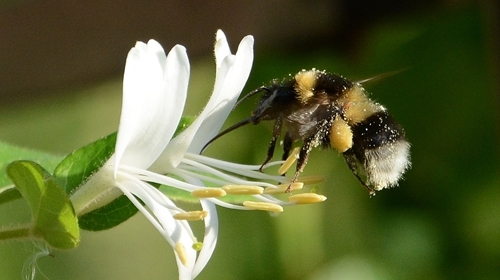By John Holland, GWCT Head of Farmland Ecology
4 minute read

This Thursday (20 May) marks the fourth annual World Bee Day. Given that more than 75% of the world’s food crops depend on pollination, it’s remarkable that this has been so long in the making (by contrast, 20 July marks the 56th International Chess Day).
This year’s theme, set by the UN, is ‘Bee engaged – Build Back Better for Bees’. That’s fine as a slogan, but what can we do? As individuals, there are things we can all do, whether it’s planting a diverse range of pollen and nectar-rich plants such as lavender, bugloss, scabious and Verbena bonariensis or creating an insect hotel in our gardens. Look out for bee-friendly labels when buying plants. These small-scale changes can make a difference, but with three-quarters of the UK managed for farming this is our real opportunity.
Broadening our appeal
In Britain, much of the public and political effort is concentrated on bumblebees, but these make up only around 10% of the total number of bee species on our shores. As a result, the flower-rich habitats on our farms have become good at supporting these species but are not attractive to other wild bee species.
To counter this one of our PhD students, Thomas Wood, examined the relationship between the diversity of plants on farmland and the diversity of bee species. He found 104 bee species (15 bumblebees, 89 solitary bees), almost half of the bee species that can be found in southern England. There was a strong correlation between the diversity of plants and bee species, so the key message was, increase the diversity of plants and the bees will follow. In another of his studies, he also found that farms with just 2.2% of the land sown with flower-rich habitat has twice as many bumblebee colonies, so agri-environment do work.
To build on this work, rather than looking at which bees visit which flowers on farms, Rachel Nichols, another PhD student supported by the GWCT’s John Holland, studied 45 different wildflowers sown in blocks to provide seed for Emorsgate Seeds. In other words, what happens when the flowers are superabundant. The findings proved fascinating. The top 14 wildflower species were visited by 37 out of the 40 wild bee species recorded and accounted for over 99% of the individual bee foraging sightings.
Right now, the flower mixes that are currently suggested by Defra either as the nectar flower mix or the flower-rich margin/plot mix contain only one each of the 18 species found to be most attractive.
For any of this to work, it needs to have achievable practical implications. The ideal mix for bees includes some weed species that farmers might be unkeen to adopt, such as bindweed, charlock, and perennial sow-thistle, but many species proved attractive to solitary bees that could be added to a mix. These include smooth hawksbeard, primrose, and wild carrot. Rachel is now trialling new seed mixes to look at how well they establish and whether the plants are still as attractive when sown as part of a mix and comparing them to the existing Defra recommendations.
A united effort
To further the impact of our work, we launched the BEESPOKE project, led by the GWCT and funded by the EU Interreg programme, North Sea Region, to increase pollinators and enhance crop pollination in the region. The project brings together 16 project partners from the United Kingdom, Belgium, the Netherlands, Denmark, Germany and Sweden including policymakers, research institutes, advisory bodies and farmer co-operatives. Through the project, pilot farms will test out crop-specific seed mixes and management methods for 14 crop types across 72 demonstration sites.
The region has been identified as having a very low pollination potential attributed to the loss of flower-rich habitats, such as meadows, while other habitats such as hedgerows have become degraded. This is also having an impact on the pollination of wild plants.
Previous GWCT-supported research showed that hedgerow plants such as hawthorn and blackthorn produced few fruits in the absence of insect pollinators. Pollinator declines, therefore, have serious implications for the survival of wild plants and also the animals that depend on the resources they provide such as seeds and fruit.
For World Bee Day we are launching a new two new BEESPOKE field guides to help farmers, growers and anyone else interested in monitoring their pollinators on crops or other flowering habitats. The first guide shows how to identify the main groups of pollinators (honeybees, bumblebees, solitary bees and hoverflies) and how to conduct a pollinator survey. The second describes how to identify some of the most common bumblebees in the UK.
Both are free to download here.
Key bee facts:
- 200,000 bee species recorded so far across the world with 270 in the UK, many are in decline
- 1/3 food we eat would not be available without bees.
- Upto £600 million - the annual economic value of bees as pollinators in the UK.
- Wild bees are responsible for pollinating 90% of the UK’s insect-pollinated crops.
- Pollen and nectar need to be on offer for 8 months of the year for bees to flourish.